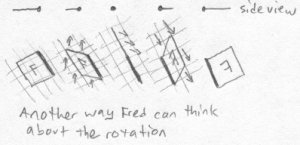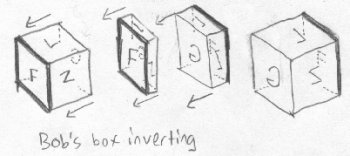gonegahgah wrote:quickfur wrote:Well, before we develop that technology, we can get a little glimpse into 4D perception by looking at projection images.

I know the projection approach does suffer from some limitations, like the "inside-out" effect of rotations, but I suspect we will still have to deal with that in a direct-to-brain approach anyway. I don't think our brains would automatically understand that as a rotation, unless we can train it by direct manipulation of 4D objects.
Our brains would take a lot of time to adjust, if they can, but a new born mind may find the task much easier.
If the 4D world is correctly put together then I suspect the new born would not experience those 'inside-out' effects; just as we don't experience them and the 2Der might think that we should. I feel the 'inside-out' effect is only due to the limitations of our 3D world canvas.
Having direct manipulation of 4D objects would do a lot to dispel the wrong interpretations of the apparent inside-out effects of 4D rotation. For one thing, most (all?) of the animations I did that show the inside-out effect is aligned in such a way that the line of sight lies in the plane of rotation. It's like when you look at a rotating 3D object at an angle perpendicular to the rotational axis, right through the middle of the object. So from a purely 2D point of view, it appears to turn "neatly" inside out.
However, from "normal" view angles, you don't really see just an inside-out effect, you see some combination of both a "normal-looking" rotation and an "inside-out looking" rotation. (The reason for deliberately meddling with the view angle to show a purely inside-out effect is, of course, for didactic reasons, since trying to explain a mixture of two effects can be very confusing to a beginner.) Just like in 3D, when we see a rotating object, it generally isn't rotating around an axis perpendicular to our line of sight, but somewhat at a slanting angle. So we will see parts of the object trace out ellipses, which our brain interprets as circles, plus some amount of "inside-out" effects, such as when a polygonal face turns over, and so forth.
Furthermore, when we are able to directly manipulate objects, like a baby playing with blocks of various 3D shapes, we don't just see a pure rotation, but we get to see how the image of the object changes in different ways when we turn it in different ways. When it falls on the floor and rolls around, that's not a pure rotation either, but a complex series of bouncing motions, with some rotation thrown into the mix, as well as translational motion, perhaps moving away from our eye so its image becomes smaller. Faced with such a complicated series of changing images, our brain has no choice but to eventually settle upon a 3D model of the world, since nothing else would adequately explain such effects.
(Well, OK, our brain
could have settled on a 4D model which would also explain these effects, but then there would be a redundant 4th axis which is not necessary to rationalize the 3D visual images, so it would just be discarded for efficiency's sake and we end up in 3D again.)
In theory, then, one might expect that playing around with 4D projection images in an application that allows (kindof) direct manipulation of the 4D object in question, our brain might eventually start forming a 4D model of the object. But there's a big discrepancy here, in that we're not really getting the full 3D images unless we have the direct-to-brain technology available, and we're also not immersed in that environment 24/7, so we're liable to just stop at a partial and perhaps inaccurate model of the 4D object. A fully immersive environment would be necessary to condition our brain to "think 4D".
I feel that even in 4D things maintain a constant relationship and it is only our experience that makes it seem otherwise.
If a 4D environment could be simulated correctly then turning things around in 4D may have no more visual conflict to a 4Der than us turning things around in our world.
Certainly, 4D things must maintain a constant relationship in spite of all appearances; that's a basic premise of higher-dimensional geometry, which would collapse on its face if it were violated.

We only think of rotating 4D objects as "morphing" or otherwise changing because our habit of thinking in 3D and unfamiliarity with 4D misleads us to interpret the projections this way.
It has always been my dream to create a 4D simulator that allows one to not only manipulate objects in a 4D way, but to have a multitude of 4D objects in the environment as well as background objects like floors, walls, ceilings, ground, sky, etc., to provide a truly immersive 4D environment. Then one can learn about how objects can obscure each other, how they bounce off 3D surfaces, and other such things that would give us a much better understanding of how 4D works.
quickfur wrote:...I know the projection approach does suffer from some limitations...
I agree that it certainly has a place and I'm wondering if I would find it useful to include projection, but through the rotated planes, in the rotated method.
That and/or intelligent slices to help give the roamer the ability to discern alignments within the 4 dimensions.
Well, I'm all curious about the final result of your rotated method.

It is certainly a fresh perspective on the subject (no pun intended!).
One of the things that I've realised with our discussions is that 4D objects still serve purposes and that many of these will overlap with the same purposes that we have too.
Yep, that's what makes dimensional analogy so useful.
[...] I guess the long term trick will be to work out what would naturally occur that wouldn't for us. [...]
If you're looking for a list of things that are unique to 4D, the
dimensional features summary page on the wiki section of this site provides a partial list. Many other details can be worked out just by exploring the implications of the listed features.
[...]
quickfur wrote:I've thought about a story idea, where the protagonists discover that their 3D world is actually a Matrix-like simulated reality, and when they "wake up" they realize they're actually 4D beings.

That would be cool.
It's just a somewhat different variation on the story idea I mentioned in the Baby Steps thread about the 4D boy who has a 3D dream. I think I like the 3D dream variation better, because it can be written in such a way that it's apparently talking about a 2D dream, but halfway into the story you suddenly realize that the protagonist is actually 4D, and is talking about 3D "flatland", not 2D flatland.















